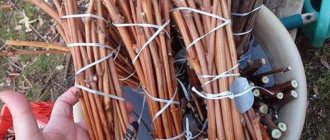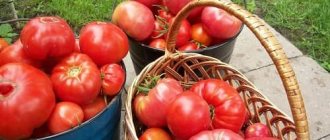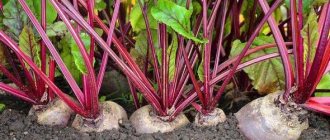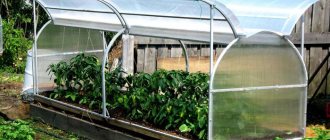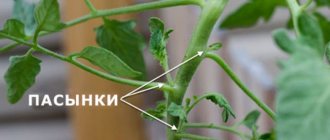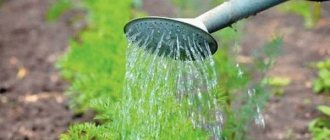The most suitable time for rooting young grape seedlings in a personal plot is the beginning of autumn.
Varieties of any fruit trees and berry bushes planted during this period have time to successfully take root before the arrival of winter, and in the new season they begin to grow faster than crops planted in the spring. And grapes in this sense are no exception. However, often the coveted planting material ends up in the hands of the gardener too late, and sometimes even the seedlings received on time cannot be planted in open ground on time. In this case, the question arises of how to preserve grape wealth until spring without loss. It is quite possible to do this if you properly arrange the plants for the winter.
How to preserve grape seedlings in winter
1. What seedlings can be stored?
Well-ripened seedlings are subject to storage. Storing vegetative seedlings or seedlings with immature growth during the winter can lead to their death. The seedlings must have labels with the name of the variety that will not deteriorate and the inscription will not be erased during storage (plastic, metal, etc.)
2. What problems may arise during storage?
Drying of seedlings, especially the roots, and the appearance of mold.
3. What are the most important indicators during storage?
The most important thing is to maintain the required temperature and humidity, and avoid over-moistening and drying out.
4. What temperature should the air be during storage?
It is necessary to maintain the temperature from 0 to +6 °C
5. What should the air humidity be?
The optimal air humidity when storing seedlings should be 75-85%.
6. What types of storage of seedlings?
The main types of storage are in the basement (cellar) and in the pit (trench).
7. How to store seedlings in the basement?
Two storage methods that we personally use: If necessary, you should treat the basement (walls, ceiling, floor) in advance (in summer) with 3% Bordeaux mixture or copper sulfate in order to protect against mold fungi. This is done every few years and repeated as necessary.
Method 1 Spread a 3-4 cm layer of sand on the floor
Place bunches of seedlings vertically along the wall close to each other and fill them halfway with wet sand. Don’t forget to put sand between the wall and the row of seedlings
Method 2 – stacking Spread sand on the floor in a layer of 3-4 cm
Lay the seedlings horizontally
Place the second row with its roots facing the first row.
Cover the roots with wet sand. If several tiers are planned for the stack, then the thickness of the sand on each layer should be 3-5 cm. The next tier is laid on top of the first, and so on. The maximum height of the stack should not exceed 1.5 m. Each layer is covered with sand. The last layer of sand is 10-15 cm. What wet sand looks like
During the entire storage period, it is necessary to check the moisture content of the sand and, if necessary, moisten it. And also ventilate and make sure there is no mold.
8. I don’t have a basement, what should I do?
As an exception, it is allowed to store seedlings in a trench (we never used it as it was unnecessary). The dimensions of the trench depend on the number of seedlings that need to be preserved; the recommended trench depth is 80-100 cm. Pour sand into the bottom in a layer of 10-15 cm, lay the seedlings in rows (tiers), sprinkling each row with wet sand. Pour a layer of sand on top so that the growth is covered by 20-25 cm, and on top of this sand - a layer of earth 20-25 cm, making a roller over the trench.
9. In the spring I took out seedlings, how can I tell if they are well preserved?
After storage in damp sand, the seedlings should have a bright green cut on the growth and elastic growth. When pruned, the roots should be cream, white or light gray in color, juicy, and elastic to the touch. After storage, before planting, seedlings need to trim the roots, refresh the top and soak in water for 12-24 hours.
10. Where seedlings should not be stored
Seedlings should not be stored in winter in warm, heated rooms, near heating devices or radiators, as well as in rooms where strong fluctuations in temperature and air humidity are possible (balconies, loggias, sheds, outbuildings, etc.)
11. And most importantly
If you doubt your ability to properly preserve seedlings, it is better to buy them in the spring.
How to prepare cuttings for storage
Before putting the cuttings away for the winter, they need to be disinfected and pathogenic bacteria and infections that will destroy the vine destroyed. It should be disinfected immediately after cutting.
- To do this, as an option, you can prepare a solution in a glass of water, dilute 5 grams. copper sulfate. You need to generously treat the chibouks and let them dry. This way you will protect against the development of fungi and diseases in winter.
- The next step is soaking. It is necessary to saturate the vine with moisture, because... Over the long winter period, the cuttings may dry out. Or the kidneys may die due to loss of moisture. You can soak for up to 24 hours.
- Dip the chopped vine thoroughly into a light pink solution of potassium permanganate for the next disinfection.
- To ensure that the cuttings lose less moisture, some winegrowers treat the edges of the cuts with paraffin. But this is at the discretion of everyone, because... the capillaries of the cut are tightened, and the moisture does not evaporate significantly.
- After all stages, sort, label and collect into bundles by variety. It is better to use plastic tags to write the name of the variety, because... Moisture can cause mold to form, which will damage the paper.
- Each bunch should be placed in a plastic bag, or wrapped in film and stored in a cool place.
The best recommendations on how to store grape seedlings and cuttings before planting
In order to plant grapes at your summer cottage when spring comes, you need to start preparing young plants in the fall. It is important for everyone who decides to grow grapes on their own plot to know how to preserve grape seedlings before planting. There are many ways to store grapes, and every gardener will be able to choose the most convenient one for himself.
Features of rooting
After gardeners have learned how to store grape seedlings in winter before planting, they need to learn about the intricacies of their rooting. The cuttings are removed from the storage location and checked for suitability. To do this, longitudinal cuts are made in the eyes of one vine of each variety. If the branches turn out to be green inside, then they can be planted. Dry and rotten chibouks will have black or brown cuts.
Then the oblique cuts at the ends of the seedlings are renewed, this will improve the formation of roots. Additionally, you need to subject the cuttings to several more procedures :
- soak;
- to plow;
- keel;
- stratify;
- stimulate.
For the first stage, melt or rain water is used. Each branch is lowered into it by 2/3 of its length and kept for three days. If the vine is overdried, then this time increases. After this, cuts are made on the lower part with a sharp knife. The vine must be kept in different temperature ranges. One option for this procedure: they dig a trench, place the lower part of the branch in it, leave the upper part in the air, and cover the top with film to create a greenhouse.
The next step is stratification. The cuttings should be placed in a warm place where the temperature reaches 20-24 degrees. The vine will wake up from hibernation, healthy seedlings will open their buds. Then they are treated with special agents that stimulate growth.
Preparation of pipes
To prepare grape cuttings, you need to know some rules:
- The stem is cut from the lower or middle part of the fruit-bearing vine. This is a requirement.
- Before cutting, the vine must be checked for maturity. To do this, you need to bend it slightly. If the vine is mature, a characteristic cracking sound will be heard.
- Additionally, the vine is checked for maturity using regular iodine. After applying iodine to a cut of the vine, it should turn black.
- You should not choose a vine that is thick or too thin. The optimal thickness for cutting a shank is 0.7 cm.
- The length of the cuttings should be 60-70 cm. When spring comes, such cuttings are cut into several more, about 25 cm each. Each of them should have 2-3 buds.
- The pipes are harvested at the end of the growing season. It is not recommended to do such an event in spring due to the low percentage of plant survival.
It is worth noting that long-established varieties are considered the most unpretentious in propagation. Such as:
How to select and cut vines
For cuttings and storing material until spring, we select healthy and mature annual shoots that do not have dents, spots, or damage. Using pruning shears or using your hands, carefully remove all leaves, shoots and tendrils, i.e. completely clean the vine.
Important! Before starting work, we check the pruning shears. The blades of the tool should be so sharp that the wood is cut and not broken.
Experienced winegrowers recommend cutting cuttings for storage with a margin of 60-70 cm. The longer the piece of vine, the better it retains moisture and nutrients. Later, in the spring, we will remove all excess and cut the cutting into 2-3 parts, taking into account the number of buds. A properly formed chibouk contains 2-4 buds.
It is advisable to cut the upper part with an even cut and the lower part with an oblique cut. This will make it easy to recognize the top and bottom of specimens prepared for wintering. In this case, we make cuts in the middle of the internodes to protect the eyes from moisture evaporation during storage.
How to care and store?
To ensure good and rapid development of the grape plant, you will need to take care of the planting material even before planting it. Sliced chibouks are prepared as follows:
- First of all, the stepsons and tendrils are removed from each cutting.
- Tied in bundles. For convenience, it is recommended to attach a label to each bunch, indicating the crop variety on it.
- As a preventive measure, the bunches are sprayed with a fungicidal solution. A 3-5% solution of copper and iron sulfate or Azophos is suitable.
We will consider below how to care for seedlings and cuttings in different conditions.
In a refrigerator
Storing cuttings in the refrigerator
To store in the refrigerator, you will need to place the prepared cuttings in an opaque (preferably) plastic bag, or a cut-off 5-liter water bottle and carefully place it in the refrigerator.
The suitable temperature for storage in this way is from +2 to +4 degrees.
Experienced gardeners also advise putting a slightly damp cloth in a plastic bag or first wrapping the cuttings in cloth and then putting the bag on. This storage option is good if you don’t have a lot of cuttings.
You can store cuttings in this way in winter - until about the end of February. Then, usually, the buds still begin to grow, even in the refrigerator. Therefore, it is worth thinking about germinating them and preparing them for planting in open ground.
In the cellar
From personal experience I can say that I cannot store cuttings in the cellar, since it is very warm and they simply germinate there in advance. But, if you have a cellar with the same year-round temperature plus 2 - 5 degrees, then it is perfectly suitable for these purposes in this article. After all, you won’t constantly hear from your wife that you’re taking up space in a small refrigerator.
In principle, everything is simple here, you need to do the following:
- Purchase plastic bags and soil for seedlings.
- The soil is steamed in advance, mixed and cooled.
- The root system of young grapes is placed in a bag and soil is gradually poured in, carefully distributing the roots of the plant. At this stage, it is important to fill all the space between the roots, leaving no air gaps or bubbles.
- Make several holes in the bag to ensure air circulation.
- Moisten the substrate with a small amount of water and tie the bag to maintain the desired level of humidity.
- For storage in the cellar, you will need to tie a bag directly above the root collar of the seedling.
Under the moss
Moss is an excellent soil replacement. The advantage of this method is that the cuttings practically do not germinate even if your room temperature is a little higher than necessary. To store grape cuttings using this method, you will need to do the following:
- First you will need to prepare a box 20 cm higher than the length of the cuttings.
- Pour 15 cm of wet moss onto the bottom of the container (can be replaced with sand or sawdust).
- The next layer is to lay out tied bunches of grapes in one row, leaving a distance of 5-7 cm from the walls of the box.
- Place another layer of moss on the cuttings. Repeat this manipulation several times.
- The last (top) layer of moss must be at least 15 cm, after which the box is covered with a lid and sent for storage in the basement or cellar.
In the trench
The method of storing grape seedlings in winter in a trench or in a trench is considered one of the most common among gardeners, especially if it is necessary to preserve a fairly large number of them. I myself use this method. In order to store seedlings in the right conditions, you will need to take into account the following nuances:
- You need to choose a sunny, dry place protected from strong winds for storage.
- The length of the trench is calculated based on the number of seedlings. Each plant requires 20 cm and 20 cm between plants.
- The trench width is at least 50 cm, depth is 55-60 cm.
- You cannot dig a trench in an area where groundwater lies close to the surface, since high humidity will provoke rotting, and there is also a risk of freezing of the roots of the crop.
- If the site has heavy soils, then spring digging and adding sand and peat are required.
- I first lay sawdust at the bottom of the dug trench, maintaining a layer thickness of 15 cm.
- Before sending for storage, I remove excess leaves directly from the seedlings and place the root system in water for 6 hours, after which I inspect the root system and remove injured and weak roots.
- After the seedlings are prepared, they can be placed in a trench. The roots should face north and the tops should face south. This technique provides maximum illumination to young grapes.
- I sprinkle the plants with soil (layer thickness 20 cm) and water them abundantly.
- Before the onset of frost, the trench must be completely covered with soil and a small mound must be made above the surface of the earth.
- You can get grape seedlings only after the soil has completely thawed, approximately in April (depending on the climate).
Related article: Catavlac - grapes
Storing seedlings on a personal plot
If you live in a private house, then you can store seedlings directly on the street. Are you afraid that they will freeze with the first frost? We offer two equally simple and effective ways to protect them from the cold:
- so-called snowmaking. This method allows you to store seedlings until planting in those regions of the country where there is snow all winter, where the height of its cover is at least 15 centimeters. Snow stores heat well, so your future plants will be very comfortable under it. To ensure the most comfortable conditions for storage, it is enough, firstly, to bury the seedlings to a depth of 8-10 cm in the snow, and secondly, sprinkle them on top with approximately the same layer of sawdust. They will act as additional thermal insulation and prevent snow from melting during short-term thaws. Finally, with such a protective layer, plants will not be afraid of even strong temperature changes;
- If snow is a problem in your region, we suggest storing seedlings in a trench. It is a trench 60-70 centimeters deep and up to half a meter wide. The length depends on the plants that you intend to immerse under the soil layer. Be sure to make sure that there is no risk of high groundwater rise in the area and that the roots will not rot due to increased humidity levels. You will also need to properly insulate the storage area - for this purpose we recommend using branches of pine or other coniferous plants, moss or sawdust. If the trench is being built on heavy soils, it is better to lighten them by mixing them with peat and sand. This will reduce the load on the seedlings and make them easy to remove before planting.
Before immersing plants in snow or an earthen trench, they must be carefully prepared. To do this, the following procedures are carried out:
- removal of excess and diseased leaves;
- immersing the roots in clean water for 3-5 hours so that they are saturated with moisture;
- removal of dead areas of the root system.
Do you have no way to store plants before planting in your garden? Then we propose to create the most comfortable conditions for them right in an ordinary city apartment
Germination
The next step after storage is germination. To do this, the grape stems need to create an optimal temperature regime: 24 degrees in the soil and 8-13 degrees in the atmosphere. Germination can be carried out in several ways, namely:
This important procedure is described in more detail in a separate article.
Each method has its own advantages and disadvantages, which we recommend that you familiarize yourself with first. Many gardeners (including me) use special preparations for rooting plants to speed up the process of root formation.
Optimal conditions for storing cuttings
The storage of grape stems must be properly organized, only then by spring they will retain their strength and be fully ready for rooting and productive growth. The optimal temperature range is from 0 to +5°C. At lower temperatures, seedlings may freeze, and at higher temperatures, the buds may swell and the roots may begin to grow prematurely. The storage location should not be exposed to direct sunlight.
Humidity level
An important condition for the safe storage of grape stems is sufficient humidity, the optimal level of which is 60%. It is with this indicator that the threat of seedlings drying out is eliminated. High humidity causes mold and plant rot. It is also necessary to ventilate the room. Often, gardeners, before placing grape shoots in a storage location, try to pre-saturate them with sufficient moisture, for which they place the seedlings in a container with water for a day.
Did you know? In terms of its nutritional composition, if you do not take into account the presence of fats, grapes are as close as possible to milk.
Disinfection
Before storing grape stems, they should be disinfected in a 3% solution of copper sulfate or a weak solution of potassium permanganate. Also suitable for this procedure is a 5% solution of ferrous sulfate or a 0.5% solution of Quinozol or Fundazol. After this, the stems must be removed from the liquid and placed in the open air to dry, only after which the seedlings can be stored. This procedure will help avoid diseases and mold in the future.
In open ground
Depending on which method was used to root the grape cuttings, the moment of planting the crop in open ground is determined. If the root system can be seen through, for example, a transparent container in which rooting was carried out, then when the roots reach 2-3 cm in length, they are transplanted into cups or bottles with soil mixture and after 2-3 weeks into the ground.
When planting grapes (seedlings and cuttings) in open ground in the spring, you need to know the following points:
Planting cuttings in the ground
- As for the temperature regime, planting in open ground is carried out when the temperature is at least 19 degrees in the soil at a depth of 10 cm.
- Before planting grapes in open ground, it is necessary to thoroughly prepare the site by applying organic and mineral fertilizers. Next, they begin to dig holes for the grapes and water them generously with water.
- A mandatory measure for beds with grapes is mulching around the sprouts using peat or wet sawdust.
In order to grow grapes, it is important to know not only the rules for caring for the crop, but also all the nuances regarding the storage of seedlings and cuttings. I tried to share with you my knowledge in this matter. And if you follow all the recommendations described above, then a good and rich grape harvest is guaranteed.
Landing in the ground
After preparation, the chibouks are planted in the ground. You need to purchase special containers in advance - pots. You can make them yourself from cut bottles, milk and juice cartons. Separately prepare the soil, consisting of earth, sand, pine sawdust and humus. Several holes are made in the bottom of the container, drainage is laid and soil is filled. It is slightly moistened, the stalk is inserted and filled to the edge of the container. Water generously and place the pot in a sunny, warm place.
Periodically, the chibouks are fed with a solution of water and wood ash . The use of chemicals is not yet recommended. If the shoots grow quickly, they are pinched. When April begins, warm and dry weather sets in, the vine is transplanted into open soil. It is important not to forget to constantly water and fertilize the plant. After planting, you can use liquid fertilizers, but in moderation.
Healthy!
The gardener must monitor the condition of the grapes. Some branches may not take root, rot or dry out and should be removed. If brown or red spots appear, the vine is treated with copper sulfate.
The process of preserving grape stems in winter is troublesome. But buying new seedlings every year will be more expensive than growing them yourself. Therefore, many gardeners learn how to handle vines during the colder months. If all conditions are met in the spring, you can get strong, healthy shoots.
Autumn harvesting of grape cuttings
Propagation of grapes by cuttings is a vegetative method. A young plant is grown from part of an adult shoot. The most suitable cuttings are from a one-year-old vine that is already bearing fruit. They are called Chubuki. Cuttings may be woody or green. If you follow the rules, the process will not seem too laborious.
In the fall, when the leaves have already fallen and frosts have not yet begun, you need to choose a healthy grapevine and trim its top part. The diameter of the vine should be up to 1 cm. Unripe tops, tendrils, and leaves must be removed from cut shoots, and be sure to preserve 4 eyes.
The cut from above should be made a few centimeters above the top bud. The lower part of the shoot is cut in three places so that the cut is about three centimeters in length. This is necessary to ensure proper metabolism for the cuttings after planting in open ground. Be sure to use a sharp knife and make the cut at an angle. Gardening tools for carrying out the procedure for harvesting cuttings must be prepared in advance and processed in order to avoid the development of diseases.
When preparing cuttings of different grape varieties for storage, it is necessary to label them and then collect them in bunches. In this form they will not infect each other. Later, the cuttings are placed in water for a day, treated with a solution of copper sulfate (5%) and left to dry completely. Copper sulfate will disinfect the branches and fill them with useful substances that will help them survive the winter. The finished cuttings are placed in a plastic bag or covered with plastic wrap and hidden for storage. Chubuki must get stronger over the winter so that they are ready for planting in early spring.
Germination of cuttings and planting
Planting cuttings in open ground is carried out in early spring. Before starting the procedure, the tufts must be prepared and rooted.
To do this, a couple of weeks before planting, they are taken out of storage and transplanted into plastic cups. This will help the plant quickly adapt and break dormancy.
First, the cuttings are soaked for up to 48 hours in warm water. Then several holes are made at the bottom of the cups. Then earth and humus. Sprinkle fine sand on top. The cutting is placed in the center to a depth of about 4 cm and then watered.
You can learn more about the process from the video.
Selection of planting material
Planting material must be chosen carefully; the success of planting depends on its quality. The cuttings must be strong and healthy. Therefore, you need to carefully examine the vine. The color of the shoots should be brown-green, uniform in color. There should be no rot, stains, cuts or damaged areas on the shoot.
Article on the topic: Sagvine tsiteli - grape variety
The diameter of the stem should be from 0.6 to 1 cm. The length can be up to 60 cm. If the shoot is too short, it may die, it will not have enough nutrients. Long shoots of grape cuttings are difficult to store. Be sure to keep up to 4 eyes on the shoot, this will allow the plant to take root better and immediately enter the development phase after transplantation.
In what month should you plant grapes?
If you use green cuttings or seedlings with a closed root system, then it is better to plant them at the very end of spring - beginning of summer. And seedlings with an open root system can be planted earlier: in late April - early May. But by this time the earth should already warm up to 10°C.
Interesting materials:
How to remove cobwebs from clothes? How to remove a stump from an apple tree? How to remove stains on drywall? How to remove stains on a stroller? How to remove glue stains from wallpaper? How to remove marker stains from a sofa? How to remove cigarette stains on a plastic window sill? How to remove a red wine stain on a sofa? How to remove a rust stain on white jeans? How to remove a tape stain?
How to store grape seedlings in winter before planting
During long-term winter storage, the plant quickly weakens, losing half of its nutrients, and gradually they become unsuitable for planting. The main task during storage is to minimize losses. Grape cuttings can be stored in the refrigerator or in the basement. You can bury the cuttings in the ground. Darkness and low temperature slow down the processes of growth and development, reducing the consumption of nutrients.
Storage in a cellar or basement
Chubuki can be stored in the basement, only the temperature in it must be constant and not fall below zero degrees. Otherwise, the air will become very cold and the vine will freeze. The temperature should not be allowed to rise above +4 degrees, otherwise the buds will swell and bloom. If you regularly ventilate the room or equip it with good ventilation, you can achieve good temperature conditions and optimal humidity.
The cuttings themselves also need ventilation. Be sure to make several holes in the plastic film that is used to wrap the cuttings. About once a month, the package must be unwrapped and the cuttings inspected to prevent mold from forming. If it appears, wipe the cuttings with a napkin soaked in copper sulfate. Cuttings can sometimes dry out, then you need to moisten the vine.
You can use wet sand or pine sawdust. They are placed in a plastic bag and the cuttings are placed there. This will help reduce nutrient loss and retain moisture.
Cold storage
How to preserve the vine at home before planting? A small number of cuttings can be stored in the refrigerator. The main thing is that the length of the vine does not exceed half a meter. Bags of cuttings are placed on the refrigerator shelves at some distance from each other, or they can be stored in a plastic bottle, as in the photo.
The chubuks are cut, treated with water and vitriol, then wrapped in thin cloth, and in this form they are placed in plastic bags. About once a month, the bundles are unrolled to moisten and treat with copper sulfate.
Trench storage
Prikop is the simplest and least labor-intensive way to store cuttings. It is necessary to dig a shallow hole, place the shoots in it, and cover it with earth. The main thing is to choose a place where the water falls and does not stagnate there. Otherwise, the cuttings will rot. Dry soil protects well from diseases, mold, and retains nutrients.
Storage tips
- Marking on bunches of seedlings of the same variety will help you quickly sort out the planting material.
- Treatment against mold fungi is mandatory, since grapes are stored in conditions of high humidity.
- In a mixture of river sand and soil, mold is less likely to grow.
- Humidifiers will relieve some of the worries about grapes.
- The growing season has begun, and there are still several months before planting. Additionally, shade the plants and soil, lower the temperature within the permissible limits. It must be above 0°C.
- Do not wrap grapes in plastic. The air will not circulate, resulting in a greenhouse effect.
How to prepare grape cuttings in spring
You can use green cuttings, which are harvested in the spring. This should be done 14 days before the flowering phase. You need to choose healthy branches, cut the cuttings, keeping 2 eyes on them. You need to cut the leaf blades in half. It is better to carry out the harvesting procedure in the morning, because at this time the plant is most saturated with moisture.
Then the cuttings are immersed in water for a day and covered with a cloth. In the meantime, take containers, put drainage from stones in them, soil for grapes, fertilizing and sand on it. The cuttings are placed at a depth of four centimeters. There should be a distance of about 10 cm between them.
The containers are covered with film, this will maintain the desired temperature and humidity. During the month, soil humidity is maintained at 100%, temperature up to 30 degrees, and air humidity at 85%. After a month, watering is reduced, the film is removed, the plant needs to be accustomed to natural conditions. At the end of summer, the chibouks are treated with fungicides to prevent the development of diseases. The cuttings are left in this form for a year in order to begin replanting next spring.
How to make your own at home
It is better to prepare grape cuttings for planting in the spring in the autumn - after the leaves fall and before the onset of frost. You need to choose a healthy vine and cut off the top part. The unripe top, tendrils, and foliage should be removed from the resulting stems, while retaining at least 4 eyes. The cuttings should be cut from below at a distance of several centimeters from the last bud, and from above - in the middle of the internode.
The lower cut is made in such a way that its length is approximately 3 cm, which is necessary to provide the cuttings with sufficient access to nutrients and better development of the root system after planting in the soil. After these procedures, the cuttings are fed with moisture and placed in a place for storage in the winter.
Important! The bottom cut should
be made at an angle, always using a sharp knife.
All equipment used is prepared in advance and disinfected to avoid the occurrence of diseases. Compliance with all the rules for wintering grape seedlings at home will help to avoid any difficulties in the matter of growing grapes, taking into account all technological requirements, and will also bring a sense of pride in the result obtained.
Typical mistakes when storing grape cuttings
- It is important that the shoots for pruning are strong and healthy. The thickness of the cuttings should be about 8 mm. It is recommended to cut the middle part of the vine; this is where a large amount of nutrients and healthy buds are concentrated.
- Cuttings often die due to lack of moisture. Therefore, they are soaked in water for 2 days.
- To protect shoots from diseases, they are treated with a solution of copper sulfate.
- If you plan to store cuttings in soil, you need to prevent rotting. It is recommended to mix the soil with sand.
Sources:
https://vinograd.info/stati/vinogradarstvo/kak-sohranit-sazhency-vinograda-v-zimnee-vremya.html https://vinodelnya.com/vyrashchivaniye/posadka/kak-sohranit-sazhency-vinograda-do-posadki / https://proposadki.ru/yagody/vinograd/kak-hranit-sazhentsy-vinograda-zimoj
How to protect pipes during storage
To ensure that the chubuki remain viable during storage, we monitor the humidity and temperature in the room. Once every 2-3 weeks we inspect the workpieces for the presence of fungus and mold. If signs of spoilage occur, be sure to separate healthy specimens from diseased specimens so that the disease does not spread to them. Rot, blackness - material to be thrown away.
For small lesions, we re-process the cuttings:
- Soak in a weak solution of soda or copper sulfate for 5-6 hours.
- Rinse with clean water and dry.
- We pack it in film and put it in the refrigerator (cellar, basement) for further storage.
If mold has only slightly affected some specimens, we do this: rinse them under running water, wipe them with a dry cloth, and again pack them in film for storage.
Where to store seedlings purchased in March?
Seedlings are stored in packaged form in rooms where it should be quite cool. Most often, experienced gardeners perfectly preserve seedlings from March until the planting dates in the following places:
- Small-sized seedlings are perfectly stored in the lower compartments of the refrigerator.
- Larger seedlings are in the cellar.
The main condition for such storage will be maintaining the room temperature at zero degrees. Under such conditions, the seedlings will have a good time waiting for planting in the basement; the fact is that such a temperature helps the seedlings go into a state of hibernation, in which they can wait until spring. Large seedlings do not need to be packaged very carefully. It is enough just to put them in containers filled with sand, which must be well moistened so that the branches do not dry out.
Read also: Small-flowered chrysanthemums planting and care in open ground
A snowdrift would be an excellent place to store seedlings. Only if it is not completely frozen, but remains loose. The seedlings really love such a delicate feather bed, but they need to be stored in a snowdrift unfolded. The only condition is to pack the root system and cover the storage area with a large amount of sawdust and shavings. To create such a storage, you need to throw snow, put seedlings in it on sawdust, then cover them with more shavings, and put a layer of snow on top again.
It is very important not to disturb the seedlings or look under the packaging. Only after a month of storage can you look under the covering material and check how much the buds have grown. These examples of seedling storage are only applicable when the seedlings are in a dormant period. If they are at the awakening stage, it is best to plant them in flower pots, and with the onset of warming, transplant them to open soil. The main thing is to observe the temperature and light conditions in the room, preventing the seedlings from overheating.
Now you know how to preserve seedlings purchased in March until planting. As for apple seedlings, it is best to store them buried in a snowdrift, or simply in a cool place, having first wrapped the rhizome in a damp cloth. Thus, seedlings purchased in advance, in March, can be completely preserved until the time of planting them on a summer cottage, the main thing is to comply with all the conditions for such storage.
See also video:
How to save seedlings?
Features of storing seedlings in an apartment
Where can you store planting material in an apartment? A refrigerator is perfect for this purpose, as it will prevent the root system from drying out and provide ideal conditions for the plant to survive the winter and be perfectly preserved until planting. This method imposes some restrictions on the size of seedlings, so it cannot be used for all fruit trees and shrubs.
Preparing a vine or sprout for refrigerated storage is carried out in several steps:
- we prepare several (according to the number of seedlings) plastic bags, and also purchase a nutrient substrate for seedlings at any specialized store;
- steam the mixture and cool it well to room temperature;
- we immerse the plant in the bag and gradually add the substrate there so that it completely occupies the space between the roots;
- moisten the composition and tie the bag tightly. A little later, you will need to make several holes in the cellophane to ensure normal ventilation and prevent rotting of the roots;
- We place the package in the so-called “freshness zone” of the refrigeration unit or simply on the bottom shelf, where the temperature is a stable 2-5 degrees above zero.
It’s great if you have a garage with a cellar or a glazed (but not insulated) balcony. In this case, you can ensure effective storage of large fruit tree seedlings.
The main goal of placing plants in the cold is to prevent them from waking up early and budding. Please check their availability regularly.
Planting grape stems in bottles. Planting grapes in autumn
Planting grapes with chibuki in the fall is often used in the south, where the climate is warm. It saves the gardener’s time, since the cuttings do not need to be stored in winter, constantly checking their condition. There is no need to root them in the spring. In a temperate climate or in Siberia, this method of planting vines is associated with the risk of seedlings freezing. Although with proper shelter it is reduced to a minimum, no matter how many degrees of frost there are outside in winter.
Preparing for landing
Before planting, so that the process of root formation goes faster and the propagation of grapes by stems becomes effective, they do keeling. To do this, the cuttings, pre-treated with fungicides, are soaked in water for a day. Then they are placed in a bottle with a special substrate. The following is used as a substrate:
- Sawdust steamed with boiling water
- Hydrogel
- Large river sand
- Sphagnum type moss.
The cuttings are placed in a moist substrate for 3-4 weeks and are periodically topped up. In such an environment, callus forms faster, from which young roots will then grow. If you plant grape stems in the fall without staking, more material is wasted.
Planting chibouks
How to plant new grapevines in the fall? There are two ways - to school and to the pits. In the first case, in the spring, the seedlings need to be moved to a permanent place. In the second, no transplant is required. The advantage of planting in a shrub is that after the winter cold you can easily discard frozen and unestablished bushes. When planting in a permanent place, the roots are not damaged, as when transferring. When is the best time to plant grapevines? This must be done before frost sets in, in the second half of October. Choose a place for planting that is bright, protected from the wind, preferably on the south side of a building or fence, on the southern slope of a hill.
Planting chibuks in a school in the fall begins with digging a trench. Its width is 30-40 cm, depth is 40-50 cm. Coarse river sand is poured onto the bottom of the trench, and on top is a layer of chernozem or a mixture of earth and humus. Grape stems are planted at an angle of 45° in a southerly direction. Water well with warm water (2-3 buckets per bush). The distance between seedlings should be 15-20 cm, between two trenches - 40 cm. It is less than when planting in holes, because further cultivation of the bushes will take place after transplantation.
The cuttings are sprinkled with earth so that 1-2 eyes remain on the surface. Then an arch 35-40 cm high is made over the trench and covered with film. In early November, the planting is insulated. They use earth, tops, reeds, and fallen leaves for this. The cover layer should be at least 0.5 m. It is best to combine materials. First add 25 cm of soil, then 10 cm of tops, leaves or straw, then another 15 cm of soil. You can simply put straw or reed mats on top.
Storage Features
Storing various garden plants (be it fruit trees, berry bushes or grapevines) has its own characteristics. Let's try to figure them out.
Coniferous plants
These plants cannot be stored in the cellar. But if they are sold in a container (and most often this is the case), they can be buried in the garden without removing them from the container, in a place protected from the wind and sun. In this case, you need to sprinkle the soil above the roots with peat to better insulate it.
The upper part of the seedling must be carefully covered with covering material. There is another good option for storing coniferous plants. An unheated garage or barn is used for this. The technology for preparing for such storage is described above. The only caveat is that you don’t need to wrap the crown of the plant.
Fruit trees
The optimal place to save fruit trees is the cellar. The method is described in detail above, but there are no special features in storing these particular plants.
Shrubs
The features of placing shrubs completely coincide with the methods of storing fruit tree seedlings. Those. The optimal places are the cellar, burial ground and snow.
The best storage methods for grapes are storage and cellar. If a trench is used, then the grape cuttings, tied in bunches, are placed in a trench (tightly). Before laying, it is recommended to dip the roots in a weak solution of potassium permanganate. This method is often practiced if there are a lot of cuttings.
The most optimal way to store roses is to store them. In extreme cases, if the rose has awakened ahead of time, use containers in cool rooms, as described above.

